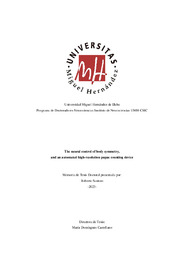Resumen :
Life is the property that distinguishes living organisms from inanimate matter, defined as the
capacity for growth, reproduction, and response to stimuli outside or from within the
organism. These properties have time in common. One stone will remain a stone after one
hundred years, but an organism will not be the same. Life has an intimate relationship with progress
and change.
Developmental biology studies the changes of an organism through time. For holometabolous insects,
such as Drosophila melanogaster, the most critical step is the onset of metamorphosis. Determining the
timing of such a crucial milestone with precision entitles scientists to uncover factors and stressors that
may accelerate, delay, prevent or cause an untimed transition and exploit the alteration to screen for
compounds and medicines that restore timed development and health.
The measurement of the timing of metamorphosis has been performed manually since the beginning of
the past century. Recently, interest in automatizing this laborious and time-consuming task has led to
several reports on possible automated solutions. However, none of the solutions achieve the precision
of manual quantification, and none are scalable. In the first section of my thesis, I will present the robot
flyGear. This robot fully automates the measurement of developmental timing for larvae and pupa
of Drosophila melanogaster and more, achieving more precision than manual scoring and is scalable.
I extensively tested the accuracy and its uses in different scenarios. The technology is now patented and
highly user-friendly. I will describe how the technology was developed and illustrate how flyGear can
precisely track pupation and the preceding wandering behaviour in a developmental timing experiment.
Living organisms are highly reactive to environmental perturbations and mutations that can affect
developmental timing and growth. Yet, they are also robust, capable of withstanding substantial
variations in size and producing perfectly symmetrical bodies. This is remarkable if one considers that
the body and parts like legs can grow for eighteen years, producing billions of cells. The final outcome
is remarkably precise, as illustrated by body symmetry.
The second section of my thesis will present new molecular and cellular mechanisms involved in
maintaining body symmetry. The preface is a journey through the animal kingdom and species with or
without bilateral external symmetry (radial and bilateral). First, I will discuss animal asymmetries,
where some regions of the body depart from the perfect bilateral symmetry, which have a genetic basis.
Then, I will discuss body asymmetries as pathological departures (fluctuating asymmetry) of expected
bilateral symmetric parts. I will introduce the basic concepts of the experimental subject of this thesis,
the geometric morphometric methods, and the genes used to decipher the circuit and logic ensuring the
symmetry of bilateral body traits.
The results section shows that commissural interneurons convey information between the left and right
parts of the central nervous system (CNS) to ensure bilateral body symmetry. Next, I will describe the
MAT (Match-maker) and GAT (Give-and-take) neurons that form the core circuit that controls bilateral
symmetry homeostasis. To conclude, I will present ex vivo calcium recording and in vivo electrical
manipulation of these neurons and a model of how these neurons correct mismatches and maintain
perfect bilateral symmetry.
|
 La licencia se describe como: Atribución-NonComercial-NoDerivada 4.0 Internacional.
La licencia se describe como: Atribución-NonComercial-NoDerivada 4.0 Internacional.
.png)
